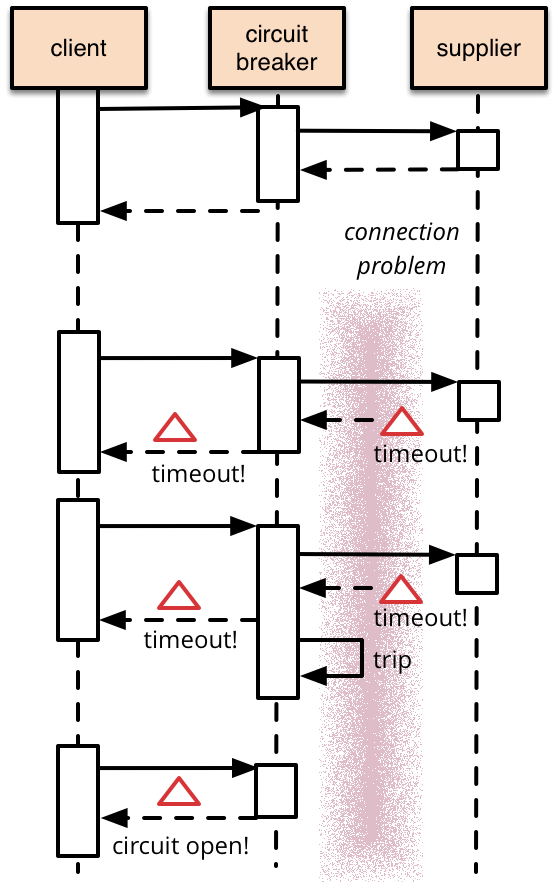Node 熔断与容灾
熔断
熔断(Circuit Breaker)直译过来就是断路开关的意思,这是一种代码模式 (pattern)。电路我们都知道,开关闭合,电路通;开关打开,电路断;其实对应我们业务代码简单来讲的话,就是正常情况下每个用户请求过来时,我们正常调用提供服务的接口获取数据(开关闭合),业务正常跑。但是当调用的接口持续出现问题,比如超时或者报错,这时候作为调用方发现了这种情况的出现,应该不再继续去调出错的接口(开关打开)。这样接口(服务)提供方有机会能恢复自身的服务。当然这里说的不再继续调用并不是永远不再调用,而是一段时间内,比如 30s,过了 30s 后会再次尝试调用服务,如果这时候发现服务正常,则我们的接口调用逻辑也恢复。如果失败,那么 30s 后再次尝试,依次类推。
容灾
顾名思义。细想我们刚刚说的熔断里的“开关打开”的情况,当开关打开时,一段时间内我们是不去调用服务的,那么这时候对于用户来的请求该怎么办?最简单的办法就是直接返回一些错误提示,比如 service unavailable 等等。不过我们还有更好的处理方式:当“开关闭合”业务正常跑时,接口是能返回正确的数据的,这时我们可以有选择性的把之前返回的正确数据放入缓存中,如果接口出现问题”开关打开“,我们可以把缓存中的这些数据拿出来返回给用户而不是返回“服务不可用”这样的提示,这就叫容灾。之所以说是有选择性,是因为有些接口的数据可能因人而异,比如每个用户访问都会得到不同于其他人的结果(比如精准投放或者用户推荐),我们只能抽样选择部分接口的数据存入缓存,等接口出问题时再把这些数据返回给所有用户,这时提供的服务是有损的,不过对于容灾来讲已经足够了,至少用户能看到有意义的数据。
opossum
三种状态
opossum 是一个基于 Node 的熔断和容灾处理库,举个例子:
const CircuitBreaker = require('opossum')
function asyncFunctionThatCouldFail (x, y) {
return new Promise((resolve, reject) => {
// Do something, maybe on the network or a disk
})
}
const options = {
timeout: 3000, // If our function takes longer than 3 seconds, trigger a failure
errorThresholdPercentage: 50, // When 50% of requests fail, trip the circuit
resetTimeout: 30000 // After 30 seconds, try again.
}
const breaker = new CircuitBreaker(asyncFunctionThatCouldFail, options)
breaker.fire(params)
.then(console.log)
.catch(console.error)
我们还可以利用回调做一些容灾的工作:
const breaker = new CircuitBreaker(asyncFunctionThatCouldFail, options)
// if asyncFunctionThatCouldFail starts to fail, firing the breaker
// will trigger our fallback function
breaker.fallback(() => 'Sorry, out of service right now')
breaker.on('fallback', (result) => reportFallbackEvent(result))

熔断触发后,circuit breaker 状态置为 open,open 状态下所有的请求会直接失败或者根据缓存的设定返回容灾数据。当我们设置的 options.resetTimeout 失效后,比如这里过 30s 后, circuit breaker 状态置为 half open,请求会再次到 api 服务,如果返回成功,则状态置为 closed,业务正常;如果返回失败,则重新进入 open 状态,且 30s 后重试,如此循环,即 circuit trip。
When a fallback function is triggered, it’s considered a failure, and the fallback function will continue to be executed until the breaker is closed.

事件监听
除了上述的 fallback,我们还可以针对其他一些事件进行监听:
- fire - emitted when the breaker is fired.
- reject - emitted when the breaker is open (or halfOpen).
- timeout - emitted when the breaker action times out.
- success - emitted when the breaker action completes successfully
- failure - emitted when the breaker action fails, called with the error
- open - emitted when the breaker state changes to open
- close - emitted when the breaker state changes to closed
- halfOpen - emitted when the breaker state changes to halfOpen
- fallback - emitted when the breaker has a fallback function and executes it
- semaphoreLocked - emitted when the breaker is at capacity and cannot execute the request
- healthCheckFailed - emitted when a user-supplied health check function returns a rejected promise
circuit.on('open',
() => $(element).append(
makeNode(`OPEN: The breaker for ${route} just opened.`)))
circuit.on('halfOpen',
() => $(element).append(
makeNode(`HALF_OPEN: The breaker for ${route} is half open.`)))
circuit.on('close',
() => $(element).append(
makeNode(`CLOSE: The breaker for ${route} has closed. Service OK.`)))
Circuit breakers are a valuable place for monitoring. Any change in breaker state should be logged and breakers should reveal details of their state for deeper monitoring. Breaker behavior is often a good source of warnings about deeper troubles in the environment. Operations staff should be able to trip or reset breakers.
参考链接
- CircuitBreaker By Martin Fowler
